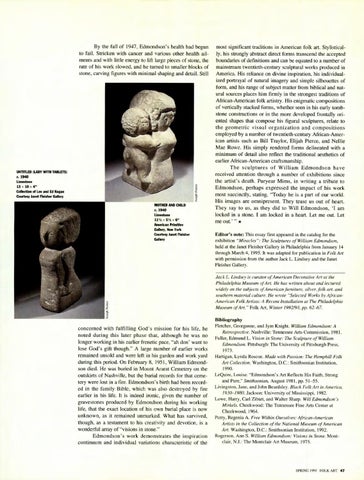By the fall of 1947, Edmondson's health had begun to fail. Stricken with cancer and various other health ailments and with little energy to lift large pieces of stone, the rate of his work slowed, and he turned to smaller blocks of stone, carving figures with minimal shaping and detail. Still
UNTITLED {LADY WITH TABLETS) c. 1940 Limestone 13 • 10 • 4" Collection of Lee and Ed Kogan Courtesy Janet Fleisher Gallery MOTHER AND CHILD c. 1940 Limestone 111 / 2 • 5/ 1 2 • 6" American Primitive Gallery, New York Courtesy Janet Fleisher Gallery
most significant traditions in American folk art. Stylistically, his strongly abstract direct forms transcend the accepted boundaries of definitions and can be equated to a number of mainstream twentieth-century sculptural works produced in America. His reliance on divine inspiration, his individualized portrayal of natural imagery and simple silhouettes of form, and his range of subject matter from biblical and natural sources places him firmly in the strongest traditions of African-American folk artistry. His enigmatic compositions of vertically stacked forms, whether seen in his early tombstone constructions or in the more developed frontally oriented shapes that compose his figural sculptures, relate to the geometric visual organization and compositions employed by a number of twentieth-century African-American artists such as Bill Traylor, Elijah Pierce, and Nellie Mae Rowe. His simply rendered forms delineated with a minimum of detail also reflect the traditional aesthetics of earlier African-American craftsmanship. The sculptures of William Edmondson have received attention through a number of exhibitions since the artist's death. Puryear Mims, in writing a tribute to Edmondson, perhaps expressed the impact of his work most succinctly, stating, "Today he is a part of our world. His images are omnipresent. They tease us out of heart. They say to us, as they did to Will Edmondson, 'I am locked in a stone. I am locked in a heart. Let me out. Let me out.'"* Editor's note: This essay first appeared in the catalog for the exhibition "Miracles": The Sculptures of William Edmondson, held at the Janet Fleisher Gallery in Philadelphia from January 14 through March 4, 1995. It was adapted for publication in Folk Art with permission from the author Jack L. Lindsey and the Janet Fleisher Gallery. Jack L Lindsey is curator ofAmerican Decorative Art at the Philadelphia Museum ofArt. He has written about and lectured widely on the subjects ofAmericanfurniture, silver,folk art, and southern material culture. He wrote "Selected Works by AfricanAmerican Folk Artists: A Recent Installation at The Philadelphia Museum ofArt," Folk Art, Winter 1992/93, pp. 62-67.
concerned with fulfilling God's mission for his life, he noted during this later phase that, although he was no longer working in his earlier frenetic pace,"alt don' want to lose God's gift though." A large number of earlier works remained unsold and were left in his garden and work yard during this period. On February 8, 1951, William Edmondson died. He was buried in Mount Ararat Cemetery on the outskirts of Nashville, but the burial records for that cemetery were lost in a fire. Edmondson's birth had been recorded in the family Bible, which was also destroyed by fire earlier in his life. It is indeed ironic, given the number of gravestones produced by Edmondson during his working life, that the exact location of his own burial place is now unknown, as it remained unmarked. What has survived, though, as a testament to his creativity and devotion, is a wonderful array of"visions in stone." Edmondson's work demonstrates the inspiration continuum and individual variations characteristic of the
Bibliography Fletcher, Georganne, and Jym Knight. William Edmondson: A Retrospective. Nashville: Tennessee Arts Commission, 1981. Fuller, Edmund L. Vision in Stone: The Sculpture of William Edmondson. Pittsburgh: The University of Pittsburgh Press, 1973. Hartigan, Lynda Roscoe. Made with Passion: The Hemphill Folk Art Collection. Washington, D.C.: Smithsonian Institution, 1990. LeQuire, Louise."Edmondson's Art Reflects His Faith, Strong and Pure," Smithsonian, August 1981, pp. 51-55. Livingston, Jane, and John Beardsley. Black Folk Art in America, 1930-1980. Jackson: University of Mississippi, 1982. Lowe, Harry, Carl Zibart, and Walter Sharp. Will Edmondson's Mirkels. Cheekwood: The Tennessee Fine Arts Center at Cheekwood, 1964. Perry, Regenia A. Free Within Ourselves: African-American Artists in the Collection ofthe National Museum ofAmenican Art. Washington, D.C.: Smithsonian Institution, 1992. Rogerson, Ann S. William Edmondson: Visions in Stone. Montclair, NJ.: The Montclair Art Museum, 1975.
SPRING 1995 FOLK ART 47
